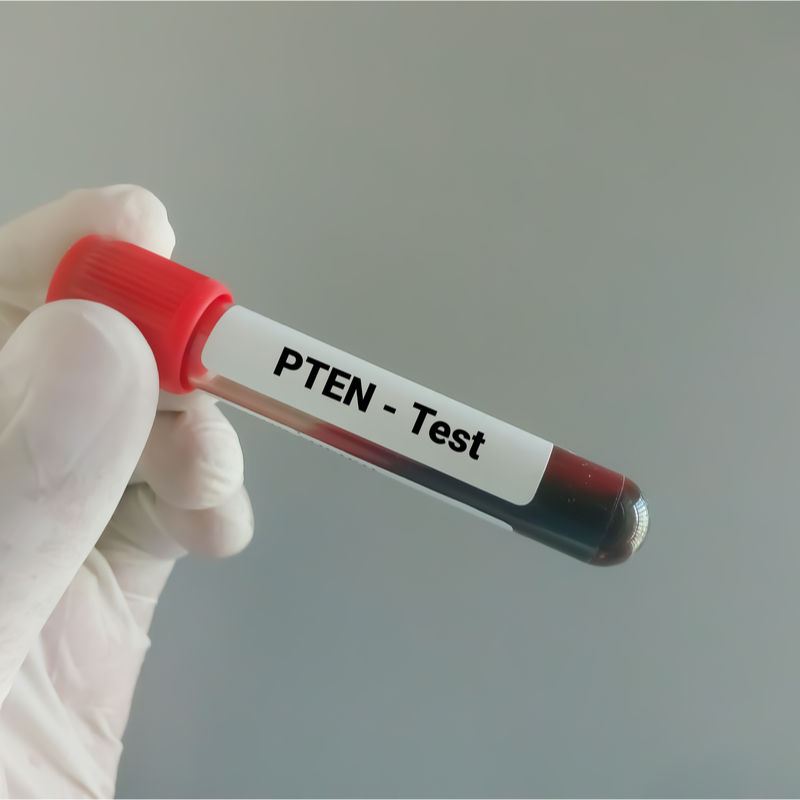
What is Bannayan-Riley-Ruvalcaba syndrome?
Bannayan-Riley-Ruvalcaba syndrome (BRRS) is a genetic disorder, which is extremely rare. BRRS is congenital and is characterised by tissue hypertrophy and rapid tissue growth (proliferation) of tumour-like cell changes (hamartomas) with the formation of many subcutaneous lipomas, haemangiomas and a large head (macrocephaly). The characteristic signs of BRRS are present from birth or become visible in early childhood.
What causes Bannayan-Riley-Ruvalcaba syndrome?
BRRS is inherited in an autosomal dominant manner. The disease is caused by a mutation of the PTEN gene in about 60 percent of all cases. The PTEN gene regulates rapid cell growth (cell proliferation). If this gene is defective, tumour-like cell changes (hamartomas) occur more frequently. In another 10 percent of all disease cases, BRRS can be triggered by a mutation or deletion of genetic material. In other cases, in which Bannayan-Riley-Ruvalcaba syndrome cannot be traced back to either a gene mutation or the PTEN gene, the cause of the disease is still unknown .
What are the symptoms of Bannayan-Riley-Ruvalcaba syndrome?
About half of all children who suffer from Bannayan-Rifley-Ruvalcaba syndrome are mentally handicapped or show delayed development. This can be particularly evident in language development, but also in motor skills such as sitting, crawling and/or walking. It is possible that these developmental delays improve with age. In addition to these signs, the following symptoms may develop in a BRRS :
- Formation of a large head (macrocephaly), without there being any expansion (dilatation) of the cerebral ventricles or increased intracranial pressure,
- tumour-like tissue changes (hamartomas), which arise from the mesoderm and can develop into intestinal polyps and/or multiple haemangiomas,
- Anomalies without health impairment (dysmorphia), which can occur especially in the face,
- global developmental delay,
- enlarged thyroid gland with multiple nodules (multinodular goiter),
In addition,
, BRRS has an increased risk of developing a cancer
. In particular, the development of a thyroid adenoma, the
development of an undifferentiated medullary thyroid cancer and
other slow-growing visceral tumours, which can cause pain and
bleeding, are attributable to a BRRS.
How is Bannayan-Riley-Ruvalcaba syndrome diagnosed?
The clinical diagnosis of Bannayan-Riley-Ruvalcaba syndrome is made by finding at least three of the following four features:
- large head (macrocephaly),
- diffuse increase in fatty tissue in different parts of the body (lipomatosis),
- Haemangiomas (blood sponges)
- mottled pigmented patches (macules) on the penis
Furthermore, it is checked whether a mutation of the PTEN gene is present in order to
secure the diagnosis, if necessary. Genetic tests
can be used for this purpose, which can detect the mutation. Also,
characteristic facial anomalies and/or skeletal malformations can indicate
a Bannayan-Riley-Ruvalcaba syndrome.
How is Bannayan-Riley-Ruvalcaba syndrome treated?
Bannayan-Riley-Ruvalcaba syndrome does not require any special treatment. If complaints or symptoms of the disease develop, they must be treated accordingly. In addition, those affected by Bannayan-Riley-Ruvalcaba syndrome are recommended to have regular cancer check-ups and screenings. In this way possible cancers that could be caused by Bannayan-Riley-Ruvalcaba syndrome can be detected early and treated. The following check-ups should be carried out in patients under 18 years of age:
- from the age of 7: annual thyroid examination by ultrasound,
- annual check-up of the skin followed by a physical examination,
- Expert assessment of neurological development,
- annual haemoglobin test to detect intestinal hamartomas as early as possible and to prevent a severe course of the disease
From
the age of 25, breast cancer surveillance should also be carried out
. Those affected should examine themselves at monthly intervals
and have a
breast examination performed by a doctor every six months. Furthermore,
with increasing age of the patient, a control examination of the kidneys
is necessary in order to be able to diagnose kidney cancer at an early stage. An annual urine test is also advisable
. Since BRRS can affect
different organ systems, a
multidisciplinary team should always be involved in the disease process.
What are the risks of Bannayan-Riley-Ruvalcaba syndrome?
Both men and women who have Bannayan-Riley-Ruvalcaba syndrome have an increased risk of developing thyroid and/or colorectal cancer. Women with a BRRS also have a higher than average tendency to develop breast cancer . In order to detect possible cancers at an early stage, it is therefore recommended that women have regular check-ups .
Women who have Bannayan-Riley-Ruvalcaba syndrome should be able to notice the first symptoms and signs of uterine cancer. These include, for example, the following warning signs, which should be clarified by a doctor as quickly as possible :
- abnormal vaginal bleeding,
- Pain in the pelvis,
- Pain during sexual intercourse,
- Pain during urination.
What is life like with Bannayan-Riley-Ruvalcaba syndrome?
The BRRS is a rare and genetic condition, so living with the condition can be a challenge . Even different people who have BRRS have experienced pain and bleeding. Even different people with Bannayan-Riley-Ruvalcaba syndrome may have different perceptions of the disease . This is not least because can always manifest different types of disease symptoms . It is therefore fundamentally important for patients to have a trustworthy medical team around them who take the concerns that arise seriously. In addition, self-help groups can bring together sufferers who are in a similar situation to share mutual concerns and problems.
